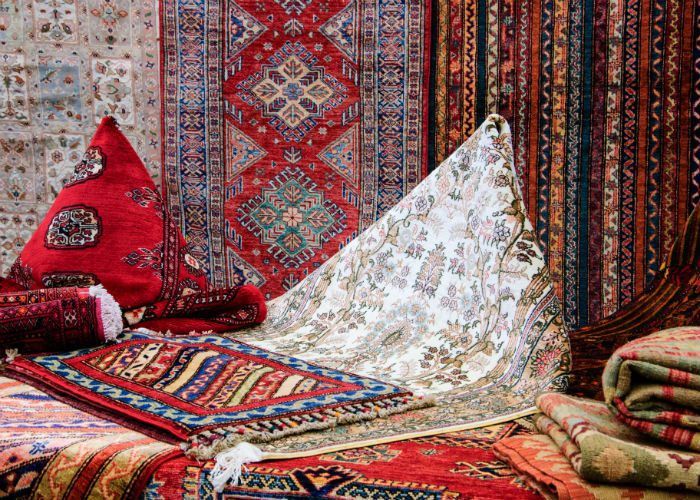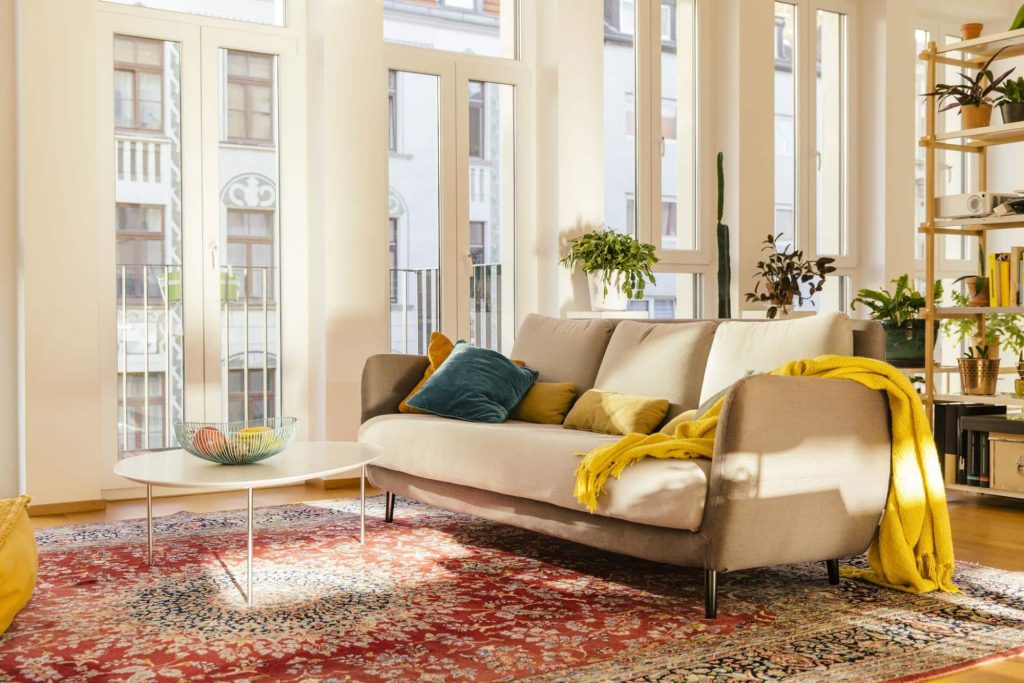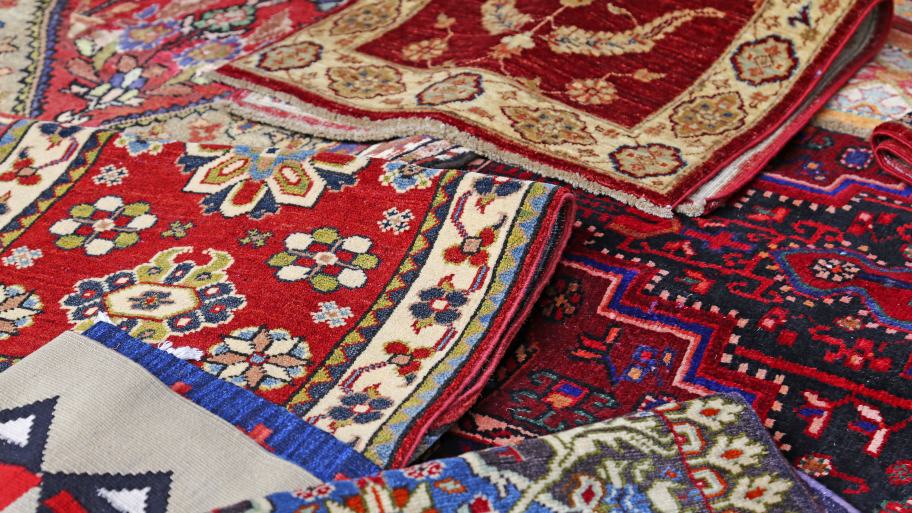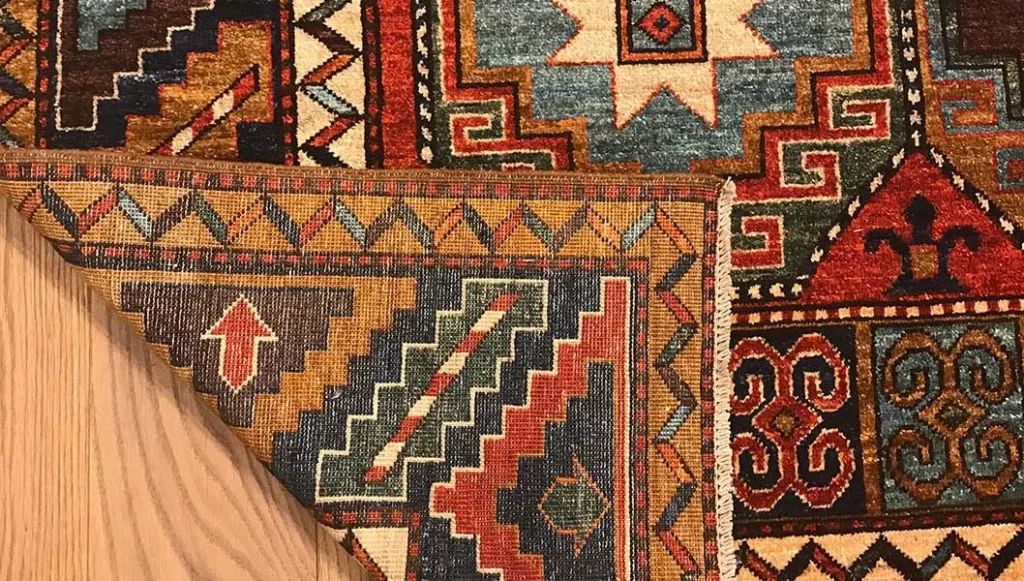As Persian rugs were always connected to luxury and wealth, many people ask themselves what is so special about them and what are real Persian rugs made of. Nowadays, although times have changed, Persian rugs remain a synonym for an exclusive piece of decor that not everyone can afford.
Real Persian rugs are made of high-quality materials, such as wool and silk fibers. They come in extremely bold and rich color combinations, very distinct knots, and unique designs.
Although there are some main things you should pay attention to when purchasing a real Persian rug, there are also some hacks and tricks we would gladly share with you. Besides knowing what are real Persian rugs made of, you need to be aware of a few other technicalities we will elaborate in the continuation of this article.

What Are Real Persian Rugs Made Of?
It’s no secret that Persian rugs are the staple of every luxuriously decorated house, palace, mansion, hotel, etc. As it takes a lot of time, resources, knowledge, and experience for them to be made, it is only understandable that their price is on the more expensive side.
Real Persian rugs are made only from the highest quality wool and cotton. Nowadays, you can see that some of them have also included silk fibers in their composition, which makes for an even softer feeling of the rug.
In the past, chrome dyes were commonly used until they got banned because of health hazards. Since then, the dyes used in these rugs have usually been naturally derived from insects and plant materials such as oak, sumac, indigo, larkspur, cochineal, madder, and pomegranate.
Nowadays, there is a lot of discussion regarding the origin of dyes because, with advanced technology, people have found new ways to produce synthetic dyes that do not fade as easily as natural ones. Ultimately, it all comes to personal preference and whether you are looking for a more authentic traditional rug or a modern take on the Persian rug.
Another characteristic of the real Persian rugs is the knot, more specifically, up to 160 knots per square inch. This unusually thick pile of knots makes the Persian rugs look different than the rest, texture-wise.
Lastly, the rugs’ names usually come from a town or a village where they are collected or woven, giving them a personal touch and character.
History of the Persian Rugs
Although Persian rugs have gone through many historical periods, with the help of the people, they have managed to preserve their original uniqueness and specialty. As the rug-making craft was passed on from generation to generation, we can still enjoy these treasures as people did 2500 years ago.
The difference between Persian and Oriental rugs
The first thing we would like to disclose is that we’ve seen many people mistake Persian rugs for Oriental rugs. Although for someone who is not very familiar with rugs, Persian and Oriental might look similar, there are great differences between them in their materials, ways of making, the origin of the dyes they are dyed with, the place they are made, etc.
The main difference between these two rugs is their place of origin. Persian rugs are usually made in modern-day Iran, while Oriental rugs come from various places around the globe, such as Tibet, Afghanistan, Iran, Iraq, Turkey, and Pakistan.
After we have disclosed this, we may move on to the origin of the Persian rugs.
The origin of the Persian rugs
The Persian rugs’ first known weaving and use are believed to be as old as 2500 years. The main function of these rugs was to serve the nomads as protection from the cold and dampness as well as to cover their floors.
As rugs gained popularity from generation to generation, art also progressed, and people started seeing these rugs not only as functional tools but as a way of expressing their feelings, thoughts, and emotions. As a result, more and more rugs were produced; therefore, the carpet-making craft and skills of the people got perfected.
When it comes to who influenced carpet weaving in Persia, many believe it was Cyprus the Great after he conquered Babylon around 539 BC. Others believe that rugs were first weaved by nomads even before Cyprus the Great’s rule.
Also read: What Size Rug for King Bed?

How Are Real Persian Rugs Made
The process of making a Persian rug is quite complicated and comes with a lot of expenses. Those that make these rugs must have excellent skills and experience as the process is not as easy as making a regular carpet. One must have an eye for detail, patience, and lots of creativity.
If you are strictly looking for a rug that comes from a unique area, you might want to go with a handmade Persian carpet but be aware that these carpets, as well as the vintage ones, cost much more than the factory ones.
Luckily today, these carpets are mass produced by machines, so we can get almost the same quality without people having to wait for months and months and without us having to pay our entire savings for them.
Persian rug components
A genuine Persian Rug has a few components it is made of.
- Medallion or symbol – the vast carpets have some kind of a medallion in the center; its shape usually is a large oval or large circle, and this part is the center of attention of the entire carpet
- Field – the colored background of the rug is called the field; the field is inside the border and on top of it is the medallion; the field can be the same color or a contrasting color to the central piece, enhancing it and making it the center of attention
- Border – Persian rugs are usually made with two borders, the primary, which is the outer one, and the guard, which is located inside the main border
Foundation of warps and knots
What makes a Persian rug differ from others is its type of knots and weaving. The first thing that should be done is the foundation of warps. For those unfamiliar with this term, warps are strong cotton, woolen, or silk threads that run along the rug’s length. On the sides, these warps usually get combined in various types of cables with different thicknesses.
Then comes the most intriguing part, the rug’s intricate patterns. They are created by tying loosely piled knots of dyed wool or silk around the previously made warp sets. Lastly, the tied knots become the rug pile because the rug’s foundation requires more rows.
The most common way that people weave these carpets is flat weaving. Although this kind of weave is more durable, they are thinner than the rest of the rugs or carpets.
Dyes
Dyes are a really big part of Persian rugs as they are what makes these rugs bold and eye-catching. From the beginning of these rugs until now, people have tended to use only natural and vegetable dyes for a more authentic appearance. In the past, at one period, chrome dyes were also used, but after a while, they got banned.
Natural and vegetable dye
Back in the day, when people did not have factories to produce billions and trillions of shades of colors, they had to use what they had, plants and insects. As the natural dyes are more durable, they quickly became the staple when it came to crafting Persian rugs. By having the basic color shades, people got creative and mixed them, so they got new, bold, and exciting colors.
The most common plants and insects used in making natural dyes are cochineals, indigo, sumac, oak, larkspur, pomegranate, and madder.
Nowadays, you can find Persian rugs with natural and synthetic colors. Both types can be classified as real Persian rugs if made authentically.
Chrome dyes
Chrome dyes were popular in the late 19th century, and because they faded fast, they were quickly considered unsuitable for dying yarns that were used in the rug-making process. That’s why in the 20th century, they got banned from the Persian government and never used again on a Persian rug.
Materials
The most used material in the making of the Persian rug is wool. This material is the most loved and preferred one, thanks to its amazingly soft texture and incredible durability. The wool used to craft these rugs is usually Iranian, but it is often imported from Australia and New Zealand to augment the reserves.
The second material used in these carpets is cotton. This material is mainly used for the foundation of these luxury rugs. But, if you want your Persian rug to be more durable, keep in mind to find one with less cotton in it, as this material is not as durable as wool.
Lastly, silk. This material is the least used one because it is the most expensive. That’s why many rug makers use only a little bit of silk to add depth to the entire concept of the rug. This material is the finest and most durable of all, but unless you want to spend an entire fortune on a rug, you will be fine without it as well.
Read more: How to Decorate Long Hallways

Persian Rug Styles
Although people classify Persian rugs as only one type of rug, there are wide varieties and styles that the original Persian rugs can come into.
Heriz rugs
With a large medallion in the center, sizable corner pieces, vibrant colors, bold and intrinsic patterns, and two to three outlines, Heriz rugs are the easiest to recognize.
Gabbeh rugs
This style corresponds to thick and coarse rugs woven by the Qashqai and Luri wavers in the Zagros Mountains. With a plain but lush color field and simple designs, they carry with them a heavy tribal influence.
Nain rugs
With the finest texture among the Persian rugs, the Nain style of rugs has 300-700 knots per square inch. The most common colors on Nain rugs are green and blue, and they are intricately patterned with branches and small flowers, usually on a white or light ivory background.
Tabriz rugs
These rugs got their name from the place where they are crafted – Tabriz, the capital of Azerbaijan. Tabriz rug is made of the highest quality silk and wool or wool piles, with a warp specifically made from cotton or silk. The patterns on these rugs are diverse, from round and teardrop medallions to trees and hunting scenes. The antique Tabriz rugs are extremely valuable and can only be found in private collections or museums.
Kashan rugs
Kashan rugs are known for their floral-patterned field with a medallion in the center and one-in-a-kind patterns on the corners. The most usual colors on these rugs are a combination of deep blue colors, ivory, and rich reds. On some occasions, colors such as burnt orange, green, and yellow may be included in patches of the design.
Isfahan rugs
With wool on a cotton or silk foundation, Isfahan rugs are one of the highest-quality pieces among Persian rugs. They are known for their dense texture that comes from their higher knot count compared to the other styles of rugs. The staple design of these rugs is balanced, meaning they usually have a design that makes them symmetrical. For instance, Isfahan rugs commonly have one rose, medallion, vines, etc.
What to Look for When Purchasing a Real Persian Rug?
Knot count
As we have mentioned earlier, knot count plays a very important role in determining whether the Persian rug is authentic or not. Real Persian rugs are made of higher KPSI, or in translation, higher knots per square inch, and they tend to be much plusher and have a more intricate design than the rugs with fewer knots per square inch.
Besides the higher knot count, all real Persian rugs are crafted uniquely with a special Persian style of knot that differs from the Oriental style of a knot as well as from all others. Keep in mind that a higher knot count does not equal higher quality. That’s why before purchasing a Persian rug, you need to see as many Persian rug styles as possible to see which one’s feel and appearance you like best.
On the other hand, other rugs with a lower knot count per square inch have simpler designs, feel less dense, and, most importantly, take less production time compared to real Persian rugs that might take months or even years to be done by hand.
Design of the rug
One of the biggest reasons why the Persian rugs still have the same or similar designs is because Iran has limited amiable interactions with Western culture and the world. Therefore, their style of artistic expression had not changed much since the times when the first original Persian rugs were created.
The most common style of real Persian rug design is an intricate and traditional design with classic motifs. The crafters of these rugs pay equal attention to every part of the rug separately, meaning they do not just make a central design, and that’s it, but they work the rug section by section.
That’s why the real Persian rugs are the ones with the most intricate details, beginning from their frames, their field, and finally, their central statement piece of art, which is usually a large oval or round medallion.
Ultimately, these rugs’ designs without the bold colors are not the same. You can rarely find a Persian carpet with a more muted and softer color palette. Almost all of the real Persian rugs from 2500 years ago up to now have bold, eye-catching colors representing the beautiful landscapes, nature, and culture these people have.
Read more: How to Clean Upholstered Chairs

Price
Although this seems obvious, do not get fooled by the higher price of the rug. Many merchants that sell fake stock put ridiculously high prices so that people think they sell original Persian rugs. Do not let the price be the only determinator of the authenticity of the particular rug.
In cases when you are sure that the rugs are real and original, choose the one whose price fits your financial possibilities best. The great thing about Persian rugs is that you can find different styles with different prices, meaning anyone can find something for themselves.
In other words, although real Persian rugs are known as exclusive and luxury carpets, thanks to the mass production of these rugs, you can own a genuine Persian rug within your budget limit.
Materials and their quality
If you see that a particular rug that’s supposed to be Persian is not made out of wool or cotton and silk, leave it where you have found it. The real Persian rugs are strictly made of wool and sometimes in combination with cotton and silk for more depth of the details on the rug itself.
Additionally, the wool must be of the highest quality and produced in Iran or imported from New Zealand and sometimes even Australia. You can recognize that a rug has been made from this wool as, on the touch, it feels plusher and is incredibly soft.
When the Persian rugs are mixed with silk or cotton, they gain this even softer and delicate texture that is hard to be replaced with any other material in the world. The feeling is truly unique; once you have felt this super soft blend, you will be able to recognize it for the rest of your life.
The modern Persian rugs contain silk fibers that provide a super-soft texture and a richer luster under your fingers.
Hand-knotted feature
This feature is of essential importance for two main reasons.
First is the price of the rug. As many scammers want to sell real Persian rugs that have been mass produced for the price of the hand-knotted rugs, you must look for this feature and ask around for the rug’s origin. Because naturally, fewer supplies, energy, money, and resources are needed for the mass production of rugs, their prices can be twice to triple lower than the hand-knotted rugs.
The second reason is the originality of the rug. If you are looking for a rug made by hand, just like the original authentic Persian rugs were made, then you must look for this label. Remember that these Persian rugs are the most expensive and exclusive, so you will have to prepare a hefty budget if you want the authentic old-fashioned real Persian rug in your collection.
Moreover, if you have a specific location in mind from where you would like your Persian rug to be, you will most probably have to go to that place, especially if it is smaller and not so popular, so you can buy the rug directly from the people who made it.
Dyes
If you want your real Persian rug to last for decades, you want to ensure that the dyes used on it are natural. You can find real Persian rugs with chemical dyes, and if the dyes are of the highest quality, you can be sure that those rugs will last you longer as well.
The secret of natural dyes is that they are much higher in quality compared to any other chemical dyes, so in the end, the decision is up to you. Also, if you want the 100% authentic and original Persian rug style, you should not choose a rug with any other type of dye but all-natural.
An important item you must pay closer attention to when it comes to dyes used in making your rug is the cleaning of the rug. You must determine which types of cleaning products and chemicals will not fade or strip the color from the rug. And if you are a lover of deep cleaning, you will need to research this topic more because your real Persian rug may lose its colors and, as a result, look dull.
Read more: How to Furnish a Long Living Room

Conclusion
We hope that with this article’s help, you became familiar with what are real Persian rugs made of, what to look for when purchasing one, and how to determine a real one from a fake Persian rug. Now that you are equipped with all this valuable knowledge, you can feel confident while deciding which real Persian rug will be a statement piece in your home.